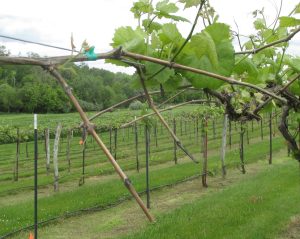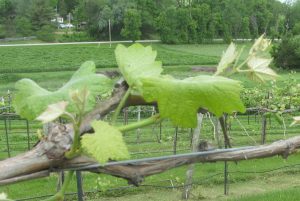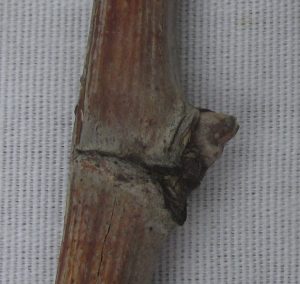Published on
Updated on
Contents:
- Update on the Frost Freeze Impact
- Managing Vineyards That Have Frost Freeze Damage
- Cumulative Growing Degree Days for the Seven Grape Growing Regions of Missouri from April 1 to May 23, 2020
- Weather Outlook
Update on the Frost Freeze Impact

This week I visited a couple of vineyards in Boone County, Missouri, that had sustained major damage from the cold temperatures on April 17-18, 2020. Both of the vineyard sites were planted on slopes and had good air drainage. The first vineyard was an approximately 6-acre block of Vivant. I estimate that approximately only 10% or less of the primary buds survived. There was extensive non-count basal buds breaking at spur positions. Fortunately the basal buds of Vivant are fruitful and there will be a crop to harvest.
The second vineyard was an approximately 3-acre block of Norton. The Norton vineyard was approximately 5 miles from the Vivant vineyard. Similar to the Vivant vines, only about 10% or less of the primary buds survived to produce primary shoots (Figure 1 & 2). There were a lot of non-count basal buds breaking at spur positions (Figure 3). Unfortunately, non-count basal buds of Norton do not produce fruit.
The most interesting thing I observed in both of these vineyards was the absence of secondary buds breaking on spurs. I collected six spurs from different grapevines in the Norton and seven spurs from the Vivant vineyard. The spurs ranged in count buds from two to five count buds for Norton, and three to five count buds for Vivant. In total, for Norton and Vivant, I dissected 20 and 25 count buds, respectively (Figure 4 & 5). For Norton, 100% of the primary buds were dead, 95% of the secondary buds were dead, and 85% of the tertiary buds were dead (Table 1). For Vivant, 100% of the primary buds were dead, and 96% of the secondary and tertiary buds were dead (Table 2).
Understandably, some vineyards were not damaged by frost or freeze events that took place in April and May 2020, whereas other vineyards like the two documented above sustained serious frost freeze damage. It is important to document and report these damages since there may be at some point this year on opportunity for grape growers that have sustained frost freeze damage to apply for certain government programs. At this time we all just have to wait and see what transpires going forward.
Besides grapes, a number of specialty crops in Missouri were damaged by the frost and freeze events in April and May. These include peaches, cherries, apples, blackberries, and strawberries, to name a few. Additionally, border states to Missouri, as well as states in the upper Midwest all the way east to New York, were impacted by the April and May frost freeze events. Widespread frost freeze damage over a large geographical area may result in the development of government assistance programs. I appreciate all of you who have taken the time to report frost freeze damage to me over the past few weeks.



Table 1. Norton buds scored as dead or alive from six different spur canes. Buds were cross-sectioned and buds that were brown were scored as dead and buds that were green scored as alive.
| Bud number | Cane | Bud position on cane with 1 being nearest cordon | Primary bud | Secondary bud | Tertiary bud |
|---|---|---|---|---|---|
| Dead/Alive | |||||
| 1 | 1 | 1 | Dead | Dead | Dead |
| 2 | 1 | 2 | Dead | Dead | Dead |
| 3 | 1 | 3 | Dead | Dead | Dead |
| 4 | 2 | 1 | Dead | Dead | Dead |
| 5 | 2 | 2 | Dead | Dead | Dead |
| 6 | 2 | 3 | Dead | Dead | Dead |
| 7 | 3 | 1 | Dead | Dead | Dead |
| 8 | 3 | 2 | Dead | Dead | Dead |
| 9 | 3 | 3 | Dead | Dead | Dead |
| 10 | 3 | 4 | Dead | Dead | Dead |
| 11 | 3 | 5 | Dead | Dead | Alive |
| 12 | 4 | 1 | Dead | Dead | Dead |
| 13 | 4 | 2 | Dead | Dead | Alive |
| 14 | 4 | 3 | Dead | Dead | Dead |
| 15 | 4 | 4 | Dead | Dead | Dead |
| 16 | 5 | 1 | Dead | Dead | Dead |
| 17 | 5 | 2 | Dead | Dead | Dead |
| 18 | 5 | 3 | Dead | Dead | Dead |
| 19 | 6 | 1 | Dead | Alive | Dead |
| 20 | 6 | 2 | Dead | Dead | Dead |
| 100% | 95% | 85% | |||
Table 2. Vivant buds scored as dead or alive from seven different spur canes. Buds were cross-sectioned and buds that were brown were scored as dead and buds that were green scored as alive.
| Bud number | Cane | Bud position on cane with 1 being nearest cordon | Primary bud | Secondary bud | Tertiary bud |
|---|---|---|---|---|---|
| Dead/Alive | |||||
| 1 | 1 | 1 | Dead | Dead | Dead |
| 2 | 1 | 2 | Dead | Dead | Dead |
| 3 | 1 | 3 | Dead | Dead | Dead |
| 4 | 2 | 1 | Dead | Dead | Dead |
| 5 | 2 | 2 | Dead | Dead | Dead |
| 6 | 2 | 3 | Dead | Dead | Dead |
| 7 | 2 | 4 | Dead | Dead | Dead |
| 8 | 3 | 1 | Dead | Dead | Dead |
| 9 | 3 | 2 | Dead | Dead | Dead |
| 10 | 3 | 3 | Dead | Dead | Dead |
| 11 | 4 | 1 | Dead | Dead | Dead |
| 12 | 4 | 2 | Dead | Dead | Dead |
| 13 | 4 | 3 | Dead | Dead | Dead |
| 14 | 5 | 1 | Dead | Dead | Dead |
| 15 | 5 | 2 | Dead | Dead | Dead |
| 16 | 5 | 3 | Dead | Dead | Dead |
| 17 | 5 | 4 | Dead | Dead | Dead |
| 18 | 6 | 1 | Dead | Dead | Dead |
| 19 | 6 | 2 | Dead | Dead | Dead |
| 20 | 6 | 3 | Dead | Alive | Alive |
| 21 | 7 | 1 | Dead | Dead | Dead |
| 22 | 7 | 2 | Dead | Dead | Dead |
| 23 | 7 | 3 | Dead | Dead | Dead |
| 24 | 7 | 4 | Dead | Dead | Dead |
| 25 | 7 | 5 | Dead | Dead | Dead |
| 100% | 96% | 96% | |||


Figure 5. Vivant bud on cane 4 bud 2 (top) and a cross-section (bottom) revealing the dead primary, secondary and tertiary buds. Photo credit: D. Volenberg
Managing Vineyards That Have Frost Freeze Damage
Understandably, vineyard owners of vineyards that have sustained excessive damage as a result of frost freeze damage want to reduce inputs to maintain a bottom line. There is the short-term vision to reduce inputs, but this short-term vision will have consequences in the longer term. I would strongly suggest that vineyards that were damaged by frost freeze events continue to be protected from pathogens. Keep protecting the crop at least until after fruit set at which time revisit and evaluate the crop. Understand that flowering and fruit set will be prolonged since secondary and in some cultivars basal buds will flower later than shoots that developed from primary buds.
For those of you who experienced the Easter freeze of 2007, a lot of data was collected from damaged vineyards that provided some tid-bits of a silver lining. If you have not looked back at this report in the past 13 years, it would be worth the read. Nevertheless, I will highlight some of the results.
- Depending on the cultivar, fruitfulness of secondary and basal buds was not high. Certain cultivars such as Chambourcin, Chardonel, and Vidal blanc typically produced ≥60% of a crop.
- Even though fruit clusters were produced from different buds (secondary and basal) at harvest the fruit quality parameters were similar. Although brix and pH did not vary greatly between clusters produced from different buds at harvest, TA was typically higher from fruit that was delayed in maturity.
- Fruit produced on count buds had similar fruit quality to fruit produced on secondary and basal buds at harvest maturity even through there were major differences in fruit quality at the onset of veraison. One caveat, remember in 2007 that most of the primary count buds were killed. In vineyards that experienced frost freeze damage this year, there is a going to be a crop produced on primary, secondary and basal buds depending on the level of frost/freeze damage to the vineyard and the cultivars ability to fruit on basal buds.
- The 2007 freeze did some damage to the vines vascular system in cordons and trunks. The 2020 frost/freeze events occurred when some cultivars were at bud-break and the temperatures did not get low enough to cause damage to cordons or trunks. Most damage in 2020 was to primary buds in most vineyards that were advanced in phenology.
- The 2007 freeze resulted in buds breaking from blind wood in cordons. Blind wood is where a spur at one time was present but over time no buds appeared to replace the spur position. This is exactly what I observed in the Norton vineyard in the article above. A number of basal buds were breaking where along the cordon where no spur position had been present in the past few years.
You can revisit the 2007 PDF report: Understanding and Preventing Freeze Damaage in Vineyards. I suggest reading “What we learned from the Easter freeze in Missouri” by Any Allen.
Another good resource for managing cold damaged grapevines is the PDF “Assessing and Managing Winter-Damaged Grapevines Part II: Early Spring” by Imed Dami et al.
Cumulative Growing Degree Days for the Seven Grape Growing Regions of Missouri from April 1 to May 23, 2020
| Region | Location by County | Growing Degree Days1 | ||
|---|---|---|---|---|
| 2020 | 2019 | 30-year Average | ||
| Augusta | St. Charles | 458 | 595 | 622 |
| Hermann | Gasconade | 445 | 589 | 600 |
| Ozark Highland | Phelps | 474 | 662 | 648 |
| Ozark Mountain | Lawrence | 497 | 654 | 630 |
| Southeast | Ste. Genevieve | 480 | 632 | 654 |
| Central | Boone | 470 | 578 | 591 |
| Western | Ray | 453 | 506 | 565 |
1 Growing degree days at base 50 from April 1 to May 16, 2020. Data compiled from Useful and Useable at U2U Decision Support Tools – Corn GDD. Click on link below to determine growing degree days in your area.
To determine the number of growing degree days accumulated in your area since April 1, use this tool.
Weather Outlook
Weather Outlook for June 1-5
- Above normal high temperatures predicted in the lower to mid 80°F.
- Below normal precipitation predicted.
May highlights
- This past week was the first time that 2-inch bare soil temperatures were above normal for the month of May. Soil temperatures ranged from 68 to 70°F across Missouri
- Both southern and northern Missouri had normal to above normal precipitation in May. Wet!
- West Central, Central, and East Central Missouri had below normal precipitation in May.